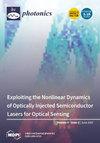风洞中使用模型俯仰-横移和俯仰-暂停模式进行的基于寿命的压敏涂料测量比较
IF 2.1
4区 物理与天体物理
Q2 OPTICS
引用次数: 0
摘要
为了提高风洞试验的数据生产率,在所谓的俯仰-横移模式下,风洞中的被测模型以预定的恒定角速度连续移动。或者,也可以采用所谓的俯仰暂停模式移动风洞模型,在该模式下,模型在固定的俯仰位置保持一定的(测量)时间,然后再移动到下一个俯仰位置。后一种方式比较耗时,因此,在相同的时间间隔内,俯仰暂停模式下的测量数据点数量要少于俯仰横移模式。由于风洞试验的时间可能相当昂贵,在大多数风洞试验中,使用传统测量系统只能记录常规的力和压力,因此风洞模型在俯仰-横移模式下移动,以便在风洞运行时间内获得尽可能多的空气动力数据。压敏涂料(PSP)技术已被广泛应用于风洞试验,以提供高空间分辨率的风洞模型压力数据。与基于强度的方法相比,基于寿命的 PSP 方法有几个优点,因为它通常具有更高的精度。到目前为止,基于寿命的 PSP 技术主要用于风洞测试,即测试模型被移动到俯仰暂停模式。使用片上累积的传统寿命法需要多个(约 1000 个)激发光脉冲,才能在相机传感器上累积足够的发光(荧光或磷光)光子,以提供可接受的信噪比,因此似乎与连续移动的风洞模型不兼容。不过,本研究验证了基于生命周期的 PSP 的应用,即利用芯片上的累积与连续移动的风洞模型相匹配,从而使整个 PSP 数据采集与上述传统测量(力和压力)相兼容。本文借助哥廷根跨音速风洞(TWG)的测量结果,研究了基于寿命的 PSP 技术在连续移动风洞模型(俯仰-横移模式)中的适用性。在这项研究中,PSP 被应用于三角翼模型 DLR-F22,该模型将在 TWG 中进行测试。使用 PSP 寿命法测量了风洞模型在两种运动模式(俯仰-暂停和俯仰-横转模式)下的压力分布,以便将相应的 PSP 结果直接进行比较。此外,还对 PSP 结果进行了误差分析,并与传统压力测量结果进行了比较,从而对 PSP 结果的准确性进行了评估;最后,还对未来的 PSP 测量提出了建议。本文章由计算机程序翻译,如有差异,请以英文原文为准。
Comparison of Lifetime-Based Pressure-Sensitive Paint Measurements in a Wind Tunnel Using Model Pitch–Traverse and Pitch–Pause Modes
In order to improve the data productivity of a wind tunnel test, the model under investigation in the wind tunnel is moved continuously with a predetermined constant angular speed in the so-called pitch–traverse mode. Alternatively, the wind tunnel model can be moved in the so-called pitch–pause mode, in which it keeps its position for a certain (measurement) time at a fixed pitch position, after which it is moved to the next pitch position. The latter procedure is more time-consuming, so, for the same time interval, the number of measured data points taken in the pitch–pause mode is less than that for the pitch–traverse mode. Since wind tunnel test time can be quite expensive, in most wind tunnel tests where only conventional forces and pressures are recorded with conventional measuring systems, the wind tunnel model is moved in the pitch–traverse mode in order to obtain as much aerodynamic data as possible during the tunnel runtime. The application of the Pressure-Sensitive Paint (PSP) technique has been widely used in wind tunnel testing for the purpose of providing pressure data on wind tunnel models with high spatial resolution. The lifetime-based PSP method has several advantages over the intensity-based method since it often has higher accuracy. Up until now, the lifetime-based PSP technique has mainly been used for wind tunnel testing, where the test model has been moved to the pitch–pause mode. The traditional lifetime method using on-chip accumulation requires multiple (~1000) excitation light pulses to accumulate enough luminescence (fluorescence or phosphorescence) photons on the camera sensor to provide acceptable signal-to-noise ratios and, therefore, it may seem to be not compatible with a continuously moving wind tunnel model. Nevertheless, the present study verifies the application of lifetime-based PSP utilizing on-chip accumulation with a continuously moving wind tunnel model which would make the entire PSP data acquisition compatible with that of the conventional measurements (forces and pressures), as mentioned above. In this paper, the applicability of the lifetime-based PSP technique to a continuously moving wind tunnel model (in pitch–traverse mode) is investigated with the help of measurements in the transonic wind tunnel in Göttingen (TWG). For this investigation, PSP was applied on the delta-wing model DLR-F22, which is to be tested in TWG. The pressure distribution on the wind tunnel model was measured using the PSP lifetime method for both model movement modes (pitch–pause and pitch–traverse mode) so that the corresponding PSP results could be directly compared with each other. In addition, an error analysis of the PSP results was carried out and compared with the conventional pressure measurement results, hence providing an assessment of the accuracy of the PSP results; finally, a recommendation for future PSP measurements could be given.
求助全文
通过发布文献求助,成功后即可免费获取论文全文。
去求助
来源期刊

Photonics
Physics and Astronomy-Instrumentation
CiteScore
2.60
自引率
20.80%
发文量
817
审稿时长
8 weeks
期刊介绍:
Photonics (ISSN 2304-6732) aims at a fast turn around time for peer-reviewing manuscripts and producing accepted articles. The online-only and open access nature of the journal will allow for a speedy and wide circulation of your research as well as review articles. We aim at establishing Photonics as a leading venue for publishing high impact fundamental research but also applications of optics and photonics. The journal particularly welcomes both theoretical (simulation) and experimental research. Our aim is to encourage scientists to publish their experimental and theoretical results in as much detail as possible. There is no restriction on the length of the papers. The full experimental details must be provided so that the results can be reproduced. Electronic files and software regarding the full details of the calculation and experimental procedure, if unable to be published in a normal way, can be deposited as supplementary material.
 求助内容:
求助内容: 应助结果提醒方式:
应助结果提醒方式:


